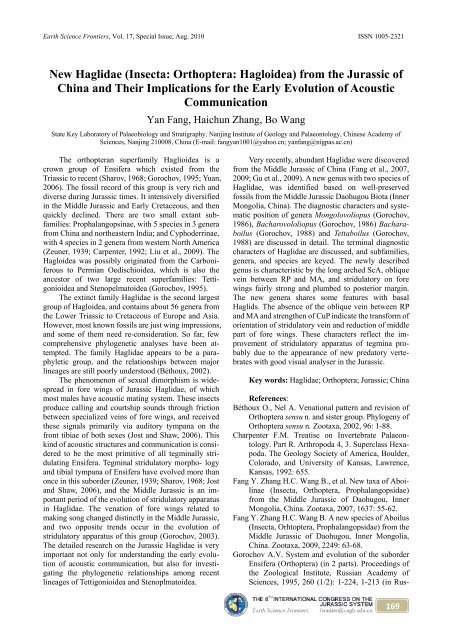in Jurassic and Cretaceous Stratigraphy
in Jurassic and Cretaceous Stratigraphy
in Jurassic and Cretaceous Stratigraphy
You also want an ePaper? Increase the reach of your titles
YUMPU automatically turns print PDFs into web optimized ePapers that Google loves.
Earth Science Frontiers, Vol. 17, Special Issue, Aug. 2010 ISSN 1005-2321<br />
New Haglidae (Insecta: Orthoptera: Hagloidea) from the <strong>Jurassic</strong> of<br />
Ch<strong>in</strong>a <strong>and</strong> Their Implications for the Early Evolution of Acoustic<br />
Communication<br />
Yan Fang, Haichun Zhang, Bo Wang<br />
State Key Laboratory of Palaeobiology <strong>and</strong> <strong>Stratigraphy</strong>, Nanj<strong>in</strong>g Institute of Geology <strong>and</strong> Palaeontology, Ch<strong>in</strong>ese Academy of<br />
Sciences, Nanj<strong>in</strong>g 210008, Ch<strong>in</strong>a (E-mail: fangyan1001@yahoo.cn; yanfang@nigpas.ac.cn)<br />
The orthopteran superfamily Haglioidea is a<br />
crown group of Ensifera which existed from the<br />
Triassic to recent (Sharov, 1968; Gorochov, 1995; Yuan,<br />
2006). The fossil record of this group is very rich <strong>and</strong><br />
diverse dur<strong>in</strong>g <strong>Jurassic</strong> times. It <strong>in</strong>tensively diversified<br />
<strong>in</strong> the Middle <strong>Jurassic</strong> <strong>and</strong> Early <strong>Cretaceous</strong>, <strong>and</strong> then<br />
quickly decl<strong>in</strong>ed. There are two small extant sub-<br />
families: Prophalangops<strong>in</strong>ae, with 5 species <strong>in</strong> 3 genera<br />
from Ch<strong>in</strong>a <strong>and</strong> northeastern India; <strong>and</strong> Cyphoderr<strong>in</strong>ae,<br />
with 4 species <strong>in</strong> 2 genera from western North America<br />
(Zeuner, 1939; Carpenter, 1992; Liu et al., 2009). The<br />
Hagloidea was possibly orig<strong>in</strong>ated from the Carboni-<br />
ferous to Permian Oedischioidea, which is also the<br />
ancestor of two large recent superfamilies: Tetti-<br />
gonioidea <strong>and</strong> Stenopelmatoidea (Gorochov, 1995).<br />
The ext<strong>in</strong>ct family Haglidae is the second largest<br />
group of Hagloidea, <strong>and</strong> conta<strong>in</strong>s about 56 genera from<br />
the Lower Triassic to <strong>Cretaceous</strong> of Europe <strong>and</strong> Asia.<br />
However, most known fossils are just w<strong>in</strong>g impressions,<br />
<strong>and</strong> some of them need re-consideration. So far, few<br />
comprehensive phylogenetic analyses have been at-<br />
tempted. The family Haglidae appears to be a para-<br />
phyletic group, <strong>and</strong> the relationships between major<br />
l<strong>in</strong>eages are still poorly understood (Béthoux, 2002).<br />
The phenomenon of sexual dimorphism is wide-<br />
spread <strong>in</strong> fore w<strong>in</strong>gs of <strong>Jurassic</strong> Haglidae, of which<br />
most males have acoustic mat<strong>in</strong>g system. These <strong>in</strong>sects<br />
produce call<strong>in</strong>g <strong>and</strong> courtship sounds through friction<br />
between specialized ve<strong>in</strong>s of fore w<strong>in</strong>gs, <strong>and</strong> received<br />
these signals primarily via auditory tympana on the<br />
front tibiae of both sexes (Jost <strong>and</strong> Shaw, 2006). This<br />
k<strong>in</strong>d of acoustic structures <strong>and</strong> communication is consi-<br />
dered to be the most primitive of all tegm<strong>in</strong>ally stri-<br />
dulat<strong>in</strong>g Ensifera. Tegm<strong>in</strong>al stridulatory morpho- logy<br />
<strong>and</strong> tibial tympana of Ensifera have evolved more than<br />
once <strong>in</strong> this suborder (Zeuner, 1939; Sharov, 1968; Jost<br />
<strong>and</strong> Shaw, 2006), <strong>and</strong> the Middle <strong>Jurassic</strong> is an im-<br />
portant period of the evolution of stridulatory apparatus<br />
<strong>in</strong> Haglidae. The venation of fore w<strong>in</strong>gs related to<br />
mak<strong>in</strong>g song changed dist<strong>in</strong>ctly <strong>in</strong> the Middle <strong>Jurassic</strong>,<br />
<strong>and</strong> two opposite trends occur <strong>in</strong> the evolution of<br />
stridulatory apparatus of this group (Gorochov, 2003).<br />
The detailed research on the <strong>Jurassic</strong> Haglidae is very<br />
important not only for underst<strong>and</strong><strong>in</strong>g the early evolu-<br />
tion of acoustic communication, but also for <strong>in</strong>vesti-<br />
gat<strong>in</strong>g the phylogenetic relationships among recent<br />
l<strong>in</strong>eages of Tettigonioidea <strong>and</strong> Stenoplmatoidea.<br />
Very recently, abundant Haglidae were discovered<br />
from the Middle <strong>Jurassic</strong> of Ch<strong>in</strong>a (Fang et al., 2007,<br />
2009; Gu et al., 2009). A new genus with two species of<br />
Haglidae, was identified based on well-preserved<br />
fossils from the Middle <strong>Jurassic</strong> Daohugou Biota (Inner<br />
Mongolia, Ch<strong>in</strong>a). The diagnostic characters <strong>and</strong> syste-<br />
matic position of genera Mongolovoliopus (Gorochov,<br />
1986), Bacharovololiopus (Gorochov, 1986) Bachara-<br />
boilus (Gorochov, 1988) <strong>and</strong> Tettaboilus (Gorochov,<br />
1988) are discussed <strong>in</strong> detail. The term<strong>in</strong>al diagnostic<br />
characters of Haglidae are discussed, <strong>and</strong> subfamilies,<br />
genera, <strong>and</strong> species are keyed. The newly described<br />
genus is characteristic by the long arched ScA, oblique<br />
ve<strong>in</strong> between RP <strong>and</strong> MA, <strong>and</strong> stridulatory on fore<br />
w<strong>in</strong>gs fairly strong <strong>and</strong> plumbed to posterior marg<strong>in</strong>.<br />
The new genera shares some features with basal<br />
Haglids. The absence of the oblique ve<strong>in</strong> between RP<br />
<strong>and</strong> MA <strong>and</strong> strengthen of CuP <strong>in</strong>dicate the transform of<br />
orientation of stridulatory ve<strong>in</strong> <strong>and</strong> reduction of middle<br />
part of fore w<strong>in</strong>gs. These characters reflect the im-<br />
provement of stridulatory apparatus of tegm<strong>in</strong>a pro-<br />
bably due to the appearance of new predatory verte-<br />
brates with good visual analyser <strong>in</strong> the <strong>Jurassic</strong>.<br />
Key words: Haglidae; Orthoptera; <strong>Jurassic</strong>; Ch<strong>in</strong>a<br />
References:<br />
Béthoux O., Nel A. Venational pattern <strong>and</strong> revision of<br />
Orthoptera sensu n. <strong>and</strong> sister group. Phylogeny of<br />
Orthoptera sensu n. Zootaxa, 2002, 96: 1-88.<br />
Charpenter F.M. Treatise on Invertebrate Palaeon-<br />
tology. Part R. Arthropoda 4, 3. Superclass Hexa-<br />
poda. The Geology Society of America, Boulder,<br />
Colorado, <strong>and</strong> University of Kansas, Lawrence,<br />
Kansas, 1992: 655.<br />
Fang Y. Zhang H.C. Wang B., et al. New taxa of Aboi-<br />
l<strong>in</strong>ae (Insecta, Orthoptera, Prophalangopsidae)<br />
from the Middle <strong>Jurassic</strong> of Daohugou, Inner<br />
Mongolia, Ch<strong>in</strong>a. Zootaxa, 2007, 1637: 55-62.<br />
Fang Y. Zhang H.C. Wang B. A new species of Aboilus<br />
(Insecta, Orhtoptera, Prophalangopsidae) from the<br />
Middle <strong>Jurassic</strong> of Daohugou, Inner Mongolia,<br />
Ch<strong>in</strong>a. Zootaxa, 2009, 2249: 63-68.<br />
Gorochov A.V. System <strong>and</strong> evolution of the suborder<br />
Ensifera (Orthoptera) (<strong>in</strong> 2 parts). Proceed<strong>in</strong>gs of<br />
the Zoological Institute, Russian Academy of<br />
Sciences, 1995, 260 (1/2): 1-224, 1-213 (<strong>in</strong> Rus-<br />
169

















